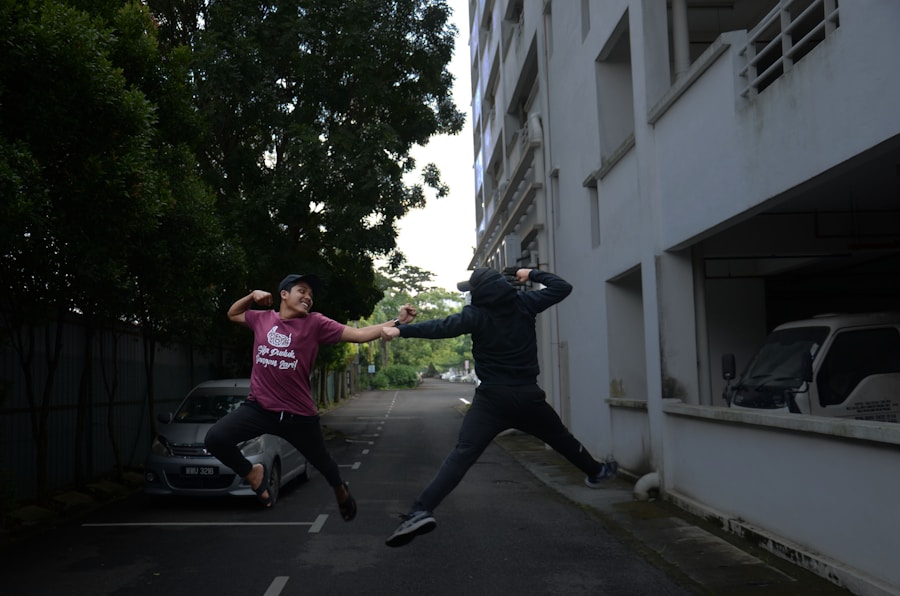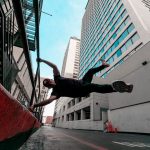Download links
How to install Mastering the Art of Parkour with taya773 APK?
1. Tap the downloaded Mastering the Art of Parkour with taya773 APK file.
2. Touch install.
3. Follow the steps on the screen.
Description
Parkour, often described as the art of movement, is a physical discipline that emphasizes efficient and fluid navigation through obstacles in one’s environment. Originating in France in the late 20th century, parkour was developed by David Belle and his peers, who sought to create a method of training that would enhance physical abilities while fostering mental resilience. The practice involves running, jumping, climbing, and vaulting over various structures, such as walls, railings, and urban landscapes.
Unlike traditional sports, parkour is not governed by strict rules or competitive elements; instead, it encourages individual expression and creativity in movement. The philosophy behind parkour extends beyond mere physicality; it embodies a mindset that values adaptability and problem-solving. Practitioners, known as traceurs (male) or traceuses (female), often view their surroundings as a playground, transforming mundane urban environments into dynamic training grounds.
This perspective fosters a unique relationship with one’s environment, promoting a sense of freedom and exploration. Parkour is not just about overcoming physical barriers; it also emphasizes mental fortitude, encouraging individuals to confront fears and push personal limits. As such, it has gained popularity not only as a sport but also as a form of self-expression and personal development.
Key Takeaways
- Parkour is a physical discipline that involves moving through urban environments using only the human body and the surroundings to propel oneself.
- Parkour training offers a wide range of benefits, including improved strength, agility, balance, and mental focus.
- Essential parkour techniques include precision jumps, wall runs, and vaults, which are used to navigate obstacles in the environment.
- Safety tips for parkour practitioners include warming up properly, using proper footwear, and always being aware of the surroundings.
- Training tips from taya773 include setting specific goals, practicing regularly, and seeking guidance from experienced practitioners.
- Taking your parkour skills to the next level involves pushing your limits, learning new techniques, and constantly challenging yourself to improve.
The Benefits of Parkour Training
Engaging in parkour offers a multitude of benefits that extend beyond physical fitness. One of the most significant advantages is the improvement of overall strength and conditioning. Parkour training involves a variety of movements that engage multiple muscle groups simultaneously.
For instance, vaulting over obstacles requires upper body strength, while running and jumping enhance cardiovascular endurance. This comprehensive approach to fitness helps practitioners develop functional strength that translates into everyday activities, making them more agile and resilient. In addition to physical benefits, parkour also promotes mental well-being.
The discipline encourages practitioners to set personal goals and work towards achieving them, fostering a sense of accomplishment and self-confidence. Overcoming obstacles—both literal and metaphorical—can lead to increased resilience and a positive mindset. Furthermore, the community aspect of parkour provides social support and camaraderie among practitioners.
Training with others fosters motivation and accountability, creating an environment where individuals can share experiences, learn from one another, and celebrate each other’s progress.
Essential Parkour Techniques

To effectively practice parkour, one must master several fundamental techniques that form the foundation of the discipline. One of the most basic yet crucial techniques is the roll. The roll is essential for safely landing from jumps or falls, distributing impact across the body to minimize injury risk.
Proper execution involves tucking the chin to the chest, rolling diagonally across the back, and using the arms to guide the body through the motion. Mastering the roll not only enhances safety but also allows for smoother transitions between movements. Another key technique is the precision jump, which involves leaping from one surface to another with accuracy and control.
This skill requires a combination of strength, balance, and spatial awareness. Practitioners often train on various surfaces to develop their ability to gauge distances accurately. The cat leap is another fundamental movement that allows traceurs to ascend vertical surfaces by jumping towards them and grabbing onto the edge with both hands.
This technique is particularly useful for scaling walls or ledges and requires upper body strength and coordination.
Safety Tips for Parkour Practitioners
| Safety Tips for Parkour Practitioners |
|---|
| 1. Warm up before starting any parkour activity to prevent injuries. |
| 2. Always practice on appropriate surfaces and avoid slippery or wet areas. |
| 3. Use proper footwear with good grip and ankle support. |
| 4. Start with basic movements and gradually progress to more advanced techniques. |
| 5. Always have a spotter or trainer present, especially when attempting new or difficult moves. |
| 6. Stay hydrated and take regular breaks to avoid fatigue and muscle strain. |
| 7. Listen to your body and don’t push yourself beyond your limits. |
| 8. Always be aware of your surroundings and potential hazards. |
Safety is paramount in parkour training, as the discipline inherently involves risk due to its dynamic nature.
Beginners should focus on mastering basic movements in controlled environments before attempting more complex maneuvers in urban settings.
This gradual approach allows practitioners to build confidence and develop the necessary skills without exposing themselves to undue risk. Another essential safety measure is to always assess the landing area before executing a jump or vault. Practitioners should look for potential hazards such as uneven surfaces, sharp objects, or unstable structures that could lead to injury.
Additionally, wearing appropriate footwear can significantly impact safety; shoes with good grip and cushioning can help prevent slips and provide adequate support during landings. Practicing with a spotter or training in groups can also enhance safety by providing additional support and guidance during challenging maneuvers.
Training Tips from taya773
Taya773, a well-known figure in the parkour community, emphasizes the importance of consistency in training. According to her philosophy, regular practice is key to mastering techniques and building strength over time. She advocates for setting specific goals for each training session, whether it’s improving a particular skill or increasing endurance.
By focusing on achievable objectives, practitioners can track their progress and stay motivated. In addition to consistency, Taya773 highlights the value of cross-training to enhance overall performance in parkour. Engaging in complementary activities such as gymnastics, martial arts, or dance can improve flexibility, coordination, and body awareness—skills that are invaluable in parkour.
She also encourages practitioners to film their training sessions to analyze their movements critically. Reviewing footage allows individuals to identify areas for improvement and refine their techniques effectively.
Taking Your Parkour Skills to the Next Level

Once practitioners have established a solid foundation in parkour techniques and safety practices, they may seek ways to elevate their skills further. One effective method is to participate in workshops or training camps led by experienced traceurs. These events provide opportunities for intensive learning and exposure to advanced techniques that may not be easily accessible in regular training sessions.
Additionally, connecting with local parkour communities can facilitate knowledge sharing and collaboration among practitioners of varying skill levels. Another avenue for skill enhancement is incorporating strength and conditioning workouts specifically tailored for parkour athletes. Exercises such as plyometrics can improve explosive power essential for jumps and vaults, while core strengthening routines can enhance stability during complex movements.
Practitioners may also explore creative movement styles such as freerunning, which incorporates acrobatic elements into parkour routines. This fusion not only adds flair but also challenges individuals to think outside the box when navigating obstacles. As practitioners continue to develop their skills, they should remain mindful of their physical limits and prioritize injury prevention strategies.
Listening to one’s body is crucial; if fatigue sets in or discomfort arises during training, it’s essential to take breaks or modify exercises accordingly. By maintaining a balanced approach that combines skill development with self-care, individuals can enjoy a sustainable journey in parkour while continually pushing their boundaries.
FAQs
What is parkour?
Parkour is a physical discipline that involves moving through an environment in a creative and efficient way, using only the human body and the surroundings to propel oneself.
Where did parkour originate?
Parkour originated in France, developed by David Belle and his group of friends in the late 1980s. It was inspired by military obstacle course training and various physical disciplines.
What are the basic movements in parkour?
Basic movements in parkour include running, jumping, climbing, vaulting, and balancing. These movements are used to navigate obstacles and terrain in a fluid and efficient manner.
Is parkour dangerous?
Parkour can be dangerous if not practiced with proper training and caution. It involves high levels of physical exertion and risk of injury, so it is important to learn from experienced practitioners and progress at a safe pace.
Is parkour a competitive sport?
While parkour is not traditionally a competitive sport, there are organized events and competitions that showcase practitioners’ skills and creativity. However, the essence of parkour is more about personal expression and overcoming physical challenges.
What are the benefits of practicing parkour?
Practicing parkour can improve strength, agility, coordination, and mental focus. It also promotes creativity, problem-solving, and adaptability in various environments. Additionally, it can be a fun and engaging form of physical activity.





